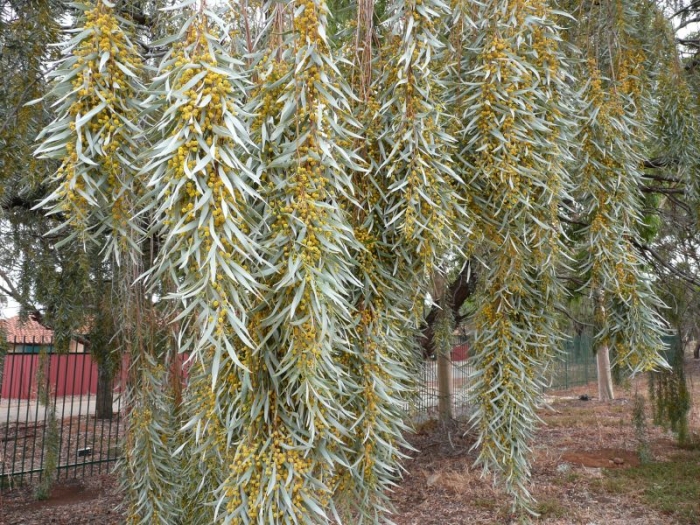Weeping Myall
(Acacia pendula)
Weeping Myall (Acacia pendula)
/
/

Sydney Oats
CC BY 2.0
Image By:
Sydney Oats
Recorded By:
Copyright:
CC BY 2.0
Copyright Notice:
Photo by: Sydney Oats | License Type: CC BY 2.0 | License URL: https://creativecommons.org/licenses/by/2.0/ | Uploader: expom2uk | Publisher: Flickr |



















Estimated Native Range
Summary
Acacia pendula, commonly known as Weeping Myall, is an evergreen tree native to semi-arid regions, including open woodlands and grasslands of Eastern Australia. This Acacia species typically grows to a height of 5 to 13 m (16 to 43 ft) and a width of 4 to 6 m (13 to 20 ft), with an erect, pendulous to spreading habit. It features hard, fissured grey bark on the trunk and limbs, and pendulous branches with angled or flattened branchlets that are initially hairy but become smooth with age. The Weeping Myall is notable for its yellow, spherical flower-heads, 3 to 7 mm in diameter, which bloom in summer and autumn from around November to May. The flowers are grouped in clusters of 10 to 20 and are followed by papery to leathery seed pods that mature to brown and are 3 to 9 cm long.
The Weeping Myall is valued for its drought and frost tolerance, making it suitable for areas with low rainfall and heavy clay soils. It is often used as a shelter tree or windbreak and is known to attract native birds, especially parrots that feed on its seeds. The tree’s ability to fix nitrogen into the soil through rhizobium nodules in its roots is beneficial for land reclamation and soil improvement. Its distinctive blue-grey foliage and weeping form are aesthetically pleasing, leading to its popularity in both domestic and international cultivation. For optimal growth, it requires full sun to part shade, low water once established, and well-drained soils.CC BY-SA 4.0
The Weeping Myall is valued for its drought and frost tolerance, making it suitable for areas with low rainfall and heavy clay soils. It is often used as a shelter tree or windbreak and is known to attract native birds, especially parrots that feed on its seeds. The tree’s ability to fix nitrogen into the soil through rhizobium nodules in its roots is beneficial for land reclamation and soil improvement. Its distinctive blue-grey foliage and weeping form are aesthetically pleasing, leading to its popularity in both domestic and international cultivation. For optimal growth, it requires full sun to part shade, low water once established, and well-drained soils.CC BY-SA 4.0
Plant Description
- Plant Type: Tree
- Height: 16-43 feet
- Width: 13-20 feet
- Growth Rate: Slow
- Flower Color: Yellow
- Flowering Season: Spring, Winter
- Leaf Retention: Evergreen
Growth Requirements
- Sun: Full Sun, Part Shade
- Water: Low
- Drainage: Fast
Common Uses
Bee Garden, Bird Garden, Drought Tolerant, Hummingbird Garden, Low Maintenance, Salt Tolerant, Street Planting
Natural Habitat
Semi-arid regions, open woodlands, and grasslands of Eastern Australia
Other Names
Common Names: True Myall , Silver-Leaf Boree , Nilyah , Treurwattel
Scientific Names: Acacia pendula , Acacia armata var. plana , Acacia leucophylla , Racosperma pendulum
GBIF Accepted Name: Acacia pendula A.Cunn. ex G.Don